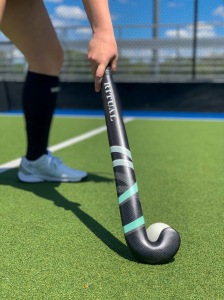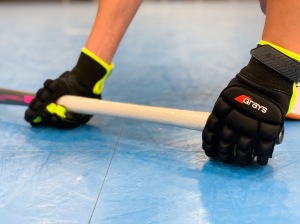Field Hockey was introduced to the United States by an English woman named Constance M.K. Applebee. Since then, the sport has developed rather quickly. Starting as a sport for women, it is now played by women and men of all age groups. It also developed into a winter indoor sport. With the move to indoors, the game changed in many ways. When looking at the difference between outdoor and indoor field hockey, you will see major differences in the field surface, measurements, number of players, rules, and even equipment.
Outdoor Field Hockey is played on grass or a synthetic field. Indoor Field Hockey can be played on a gymnasium floor, linoleum, or snap tiles, making it a much faster paced game. Although the game is a faster pace indoors, it is a much smaller court, requiring players to use the basic skills of passing and pulls. The typical outdoor Field Hockey playing area is measured at 100 yards by 60 yards. Compared to the outdoor field, the indoor court is much smaller; measured at 39 to 48 yards by 19 to 24 yards. The sidelines in indoor field hockey are actually replaced with boards. This allows players to use the boards to pass to each other. Out of bounds occurs when the ball goes over the boards or if it rolls out on the end lines.
Because of the large difference in the size of the field, there are less players out on an indoor court at a time. Your typical 10 field players and 1 goalie turns into 5 field players and 1 goalie. This means that the team is limited as to what formation they can play. Some teams choose the formation consisting of 2 forwards, 1 midfield, and 2 defenders. But, all positions are expected to move up and down the court as one unit.
With the exception of one rule, the rules of outdoor field hockey are consistent with indoor. For example, the ball must travel a certain distance before entering the circle on free hits, no hacking, the ball cannot touch your feet, etc. The number one difference between outdoor and indoor is lifting. In outdoor, players can lift the ball over the opponents stick and they can use aerials to create space or an opportunity for a breakaway. On the other hand, there are no lifts allowed in indoor field hockey. The only exception is that players may lift only if it is on goal. Corners also look a bit different compared to outdoor play. On a typical outdoor corner, the defense is only allowed 4 field players and 1 goalie in the cage. Whereas, the offense can have as many players on the circle as they would like. In indoor, both the defensive and the offensive team can have as many players as they would like to, in the cage and on the circle, respectively. The rule stays the same that no one can enter the circle until the ball is inserted and the ball must come out of the circle in order for the corner to count.
Even the equipment is different between outdoor and indoor field hockey. Essentially, the only real difference is the stick. Outdoor sticks are required to have a thicker toe in order to accommodate for the powerful drives and hits. Indoor sticks look a little different. The toe, and the stick in general, is much lighter and thinner. This is because there are no drives allowed indoors. The thinner toe also allows for complete ball control while moving at a faster pace. You will also see players wearing protective gloves. Since there is no lifting, players will keep their hands close to the ground which allows for a better chance of getting hit by the ball or a stick.
If you are a player looking to keep up with your skills in the off season, consider looking into a local indoor team. It is a great opportunity to stay in shape, keep up with your skills, and make new friends.




